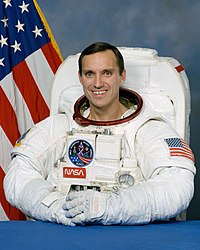Carl E. Walz
| Carl E. Walz | |
|---|---|

|
|
| Country: | United States |
| Organization: | NASA |
| selected on | Jan 17, 1990 (13th NASA Group) |
| Calls: | 4 space flights |
| Start of the first space flight: |
September 12, 1993 |
| Landing of the last space flight: |
June 19, 2002 |
| Time in space: | 230d 13h 04m |
| EVA inserts: | 3 |
| EVA total duration: | 18h 55m |
| retired on | December 5, 2008 |
| Space flights | |
Carl Erwin Walz (born September 6, 1955 in Cleveland , Ohio ) is a retired American astronaut .
Walz received a bachelor's degree in physics from Kent State University in Ohio in 1977 and a master's degree in solid state physics from John Carroll University in Ohio in 1979 . From 1979 to 1982 he was responsible for the analysis of radioactive samples from the Atomic Energy Detection System at McClellan Air Force Base . The following year he was trained as a flight test engineer at the test pilot school at Edwards Air Force Base and worked there until 1990.
Astronaut activity
Carl Walz was selected in January 1990 with the 13th astronaut group.
STS-51
On September 12, 1993, he took off with the Discovery as part of the STS-51 mission on its first flight into space. He suspended the Advanced Communications Technology Satellite (ACTS) and the Shuttle Pallet Satellite ( ORFEUS -SPAS). The latter American and German scientific experiments had including an ultraviolet - spectrometer on board. In a seven-hour spacewalk proven Walz and his colleague James H. Newman tools and methods to repair the Hubble Space Telescope . After ORFEUS-SPAS had flown freely for six days and had moved approx. 65 km away from the Discovery, it was finally caught again with the help of the shuttle robot arm. After circumnavigating the earth 158 times, the Discovery was the first shuttle to land at the Kennedy Space Center that night .
STS-65
On July 8, 1994 , he flew into space on the Columbia space shuttle for the STS-65 mission. Around seven dozen experiments from the fields of biology and materials science were on the program during the 15-day Spacelab flight. On July 23, he landed at the Kennedy Space Center in Florida .
STS-79
STS-79 launched on September 16, 1996 to the Mir space station from the Kennedy Space Center, where the mission later ended again. The space shuttle Atlantis was docked to the space station for four days. On this mission, the Mir crew member Shannon Lucid was replaced by John E. Blaha , who flew back on STS-81 . After the exchange of supplies and experiments, the mission returned to Earth on September 26, 1996. The flight lasted 10 days, 3 hours and 19 minutes.
ISS expedition 4
Most recently, Walz started on December 5, 2001 as a flight engineer of the fourth long-term crew together with Juri Onufrijenko and Daniel W. Bursch with the space shuttle Endeavor ( STS-108 ) to the International Space Station (ISS). On January 14, 2002, Walz undertook an outboard operation with Onufrijenko and relocated the cargo boom for the Russian Strela crane from the PMA-1 coupling adapter to the exterior of the docking device of the Pirs module. In addition, a was amateur radio - antenna of at the end of the Zvezda modulus installed ( ARISS project). This spacecraft lasted six hours and three minutes. The next spacecraft mission that Walz and Bursch undertook on February 20, 2002 was only slightly shorter at 5 hours and 49 minutes. The Quest airlock was tested and prepared for future exits. Another highlight of the ISS expedition 4 was the visit to the space shuttle Atlantis in April 2002. During this mission ( STS-110 ) the grid element S0 was brought to the ISS and installed. After a flight time of 195 days, 19 hours and 39 minutes, Walz returned to Earth on June 19, 2002 on the Space Shuttle Endeavor with the STS-111 mission . With this, Bursch and Walz held the record for the longest single US space flight until 2007.
According to NASA
Walz left NASA on December 5, 2008 to take up a position in industry.
Private
Walz and his wife have two children.
See also
- List of spacemen
- List of space shuttle missions
- List of manned space flights
- List of space exits
- List of ISS expeditions
- List of manned missions to the International Space Station
Web links
- Short biography of Carl E. Walz at spacefacts.de
- NASA biography of Carl E. Walz (English; PDF)
- Biography of Carl E. Walz in the Encyclopedia Astronautica (English)
Individual evidence
- ↑ Veteran astronaut Carl Walz Leaves NASA. NASA, December 4, 2008, accessed December 10, 2008 .
| personal data | |
|---|---|
| SURNAME | Walz, Carl E. |
| ALTERNATIVE NAMES | Walz, Carl Erwin (full name) |
| BRIEF DESCRIPTION | American astronaut |
| DATE OF BIRTH | September 6, 1955 |
| PLACE OF BIRTH | Cleveland , Ohio |
